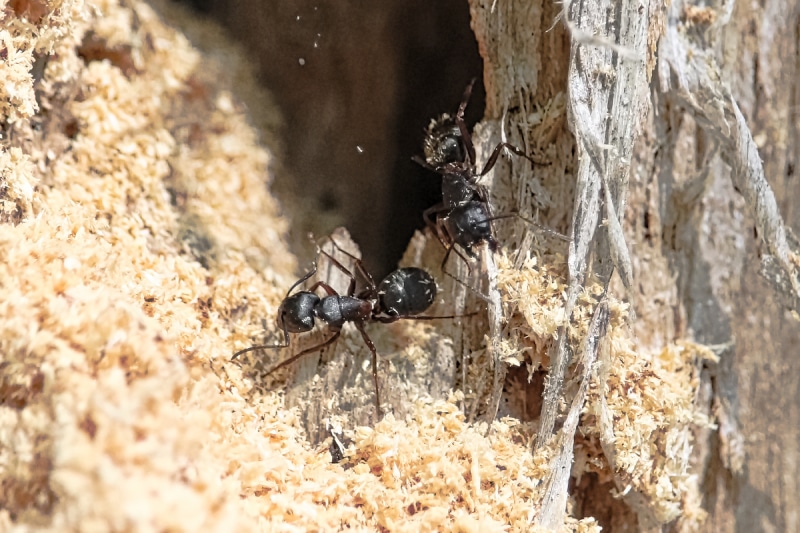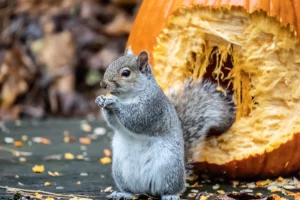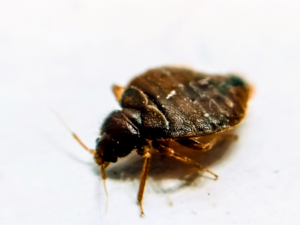Home / Blog / Ants / Wood Destroying Insects And What You Need To Know About Them
Wood Destroying Insects And What You Need To Know About Them

Scientifically reviewed by Daniel Baldwin, BCE, CCFS, CP-FS
-Published on September 20, 2021
-Updated on July 13, 2023
Insects that bore and drill holes in wood may be tiny, but their activities can add up to big damage. In fact, wood-destroying insects cause an estimated $5 billion in property damage every year in the U.S. Read on to learn more about the types of wood-destroying insects to keep a lookout for.
Which insects eat wood?
A variety of insects eat wood or make their homes in wood. Termites, carpenters ants, and wood beetles are the most well-known problem pests.
Termites
Termites are one of the most well-known wood-destroying insects. They live in every state in the U.S. You can recognize termites by their brown, black, and beige bodies with defined waists and straight antennae. Some have wings, but not all species do.
Eastern subterranean termites are the most common. They live in colonies with a queen and make their nests in the ground. Termites don’t actually eat wood; they feed on the cellulose found in wood. The pests will seek out the material in wood piles and the structure of homes.
Carpenter ants
Carpenter ants make their homes in cool, damp climates throughout the United States. You can typically find their tunnels in window and door frames, crawl spaces, chimneys, and roofs.
To tell carpenter ants and termites apart, look at their antennae. Ants have bent antennae, while termites’ are straight. Carpenter ants can be black, red, or brown in color.
Unlike termites, carpenter ants don’t eat materials in wood. Instead, they burrow into wood to build tunnels and nests. When this occurs, the pests may leave behind piles of wood shavings that look similar to sawdust. You may also find shed wings near areas where carpenter ants have burrowed.
Wood beetles
There are several types of wood-destroying beetles, all of which are quite destructive. Common varieties include:
- True powderpost beetles: These flat-headed beetles measure 3 to 7 millimeters in length and are usually reddish-brown in color
- False powderpost beetles: These beetles are similar in size and color to true powderpost beetles but have a more cylindrical head. They also have spines on their thoraxes, while true powderpost beetles do not.
- Long-horned beetles: These beetles are typically around 16 to 25 mm long. They usually feature gray–black or brown bodies and have white spots on their wings.
- Metallic wood-boring beetles: These beetles range anywhere from 6 to 25 mm in length and are easy to identify thanks to the metallic sheen on their dark-colored bodies.
Once an infestation begins, they are challenging to control, which is why prevention is so important. All species of these wood-boring beetles have two wings. Their colors vary, but they typically have bodies that look rounder than those of termites or carpenter ants.
Which insects destroy wooden furniture?
While any wood-destroying insects could damage wooden furniture, wood beetles are the most likely culprits. The wood-boring insects with wings may lay their eggs inside the wood. When the larvae hatch, they burrow out of the furniture, making holes and tunnels.
What are the signs of wood-destroying insects?
The longer an infestation continues, the more likely your home and furniture will suffer severe damage. Taking action quickly when you see the signs of wood-destroying insects can limit the effects of wood beetles, termites, and carpenter ants.
Some warning signs to look out for include:
- Small pin-sized holes in wood on the inside or outside of your home
- Small pin-sized holes in wood furniture
- Dry chips or bits of wood inside your home
- Sawdust
- Peeling paint
- Shed wings from carpenter ants
- Seeing large numbers of ants, termites, or beetles in an area
Damage from wood pests vs. rodents
Homeowners may mistake mice and rats chew marks for insect wood damage. If you have an rodent in your home that is gnawing on wood, you’re also likely to find droppings in the affected area. If you see droppings that are black and rice-shaped, it’s likely mouse droppings; if you see some that are slightly wider and between ½ inch and ¾ inch, you may have a rat problem. These are a good indication that the problem is due to rodents rather than wood-destroying insects. Additional signs of a rodent infestation include foul odors from urine and feces and strewn nesting materials like fabric and shredded paper.
How to protect wood from insects
To protect wood in your home or business from wood-destroying insects, follow these tips.
Prevent water damage in the first place
Water damage softens wood, making it easier for some wood-boring insects to eat or tunnel through. To keep your home dry:
- Clean your gutters regularly
- Replace worn-out weather stripping around windows and doors
- Install and use a sump pump to prevent flooding in basements and crawl spaces
- Use a dehumidifier to reduce moisture in basements
- Fix leaks quickly when they occur
- Seal cracks and gaps in your home’s exterior
If water damage does occur, hire a cleanup company to help you dry out your home.
Finish wood
Don’t leave wooden structures and furniture unfinished. Apply varnish, stain, or paint to create a protective coating. For wood exposed to the elements, use a waterproof wood sealant.
Tidy up your yard
Remove all wooden debris from your yard, like sticks, tree stumps and fallen limbs. If you have a wood pile outside, use a waterproof and insect-proof cover to shield it from the elements and pests.
Keep your trash covered
Uncovered garbage can provide food for carpenter ants. Always keep your trash in cans with tight-fitting lids and keep the lid on when you’re not actively using them. Clean your garbage cans every two to three weeks, and store the cans as far from your home as possible.
Pest control services
Hawx Pest Control can help you deal with wood-destroying insects. Our licensed pest control technicians can identify infestation sites and develop treatment plans that use high-quality products and state-of-the-art technologies to address termites, carpenter ants, and other wood-boring insects. In addition, our technicians can provide you with prevention tips to reduce the risk of pests returning in the future. If necessary, they can recommend a maintenance schedule for future preventative treatments.
Related Articles
Visit our blog to learn more.
→









